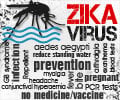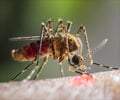- Zika virus infection is transmitted through the bite of infected mosquitoes and currently has no vaccine or cure.
- Zika virus infection during pregnancy is associated with birth defects and some persons develop Guillain-Barre syndrome, a rare condition affecting the brain.
- Mechanism by which neutralizing antibody disrupts critical step in the infection process has been identified.
- The discovery could lead to development of drugs and preventive vaccines
Reason for Study
The research team which undertook the current study had isolated the antibody in an earlier research published early this year. The antibody was isolated from the blood of a person who had recovered from Zika infection. They found that the antibody was capable of neutralizing American, African and Asian strains of the virus and in addition decreased fetal infection and death in mice."However, until now what remained unknown was the mechanism of neutralization of Zika infection by the antibody and the structural basis for neutralization," said Michael Rossmann, Purdue's Hanley Distinguished Professor of Biological Sciences.
Methods of the Study
The research team determined the three-dimensional structure of the Zika virus while attached to a key binding site on the antibody known as the antigen binding fragment, or a Fab molecule. They were also able to find how the virus infects the host cell and the manner in which the neutralizing antibody prevents this critical step,The structure was determined by a technique called cryo-electron microscopy at a resolution of 6.2 Angstroms. The following were the observations
- The genome of the Zika virus is situated within a protective shell that is composed of 60 repeating units, each unit containing three envelope proteins, or E proteins.
- When the virus attaches to the host cell's outer membrane a difference in pH, or acidity, in the membrane causes the envelope proteins to expose "fusion peptides," resulting in the transfer of the viral RNA genome, a critical step in the infection process.
- The binding of the neutralizing antibody to Zika inhibits this important pH-triggering mechanism, thereby neutralizing the virus by "cross-linking" the E proteins, and closing them up and preventing the exposure of fusion peptides.
Moreover, considering that the surface of Zika is made of 60 copies of three E proteins, it would be expected that 180 copies of the antibody's Fab molecules would be needed for neutralization.
Zika Virus Infection
Zika virus belongs to the Flavivirus family which includes dengue, West Nile, yellow fever, Japanese encephalitis and tick-borne encephalitic viruses.Zika virus infection is transmitted through the bite of infected mosquitoes and recent research has established that maternal to fetus transmission and sexual transmission is also possible.
When pregnant women get Zika virus infection, there is an increased risk of fetal birth defects such as microcephaly, other brain defects, hearing and visual impairment and impaired growth. Also it is thought to be associated with Guillain-Barre syndrome a disorder of the brain.
"Given the severity of the symptoms caused by Zika infection in humans, it is crucial to understand the immune response elicited by the infection to develop neutralizing anti-Zika therapies," Rossmann said.
Scope of the Study
- The findings of the study could be used for the development of antiviral medications
- Future research can focus on other sites on the viral surface where antibodies can attach, which would be of use in the development of vaccines.
- Zika Virus - Overview - (https://www.cdc.gov/zika/about/overview.html)
- Zika virus - (http://www.who.int/mediacentre/factsheets/zika/en/)














